Kobukusa and Mandala Part 1
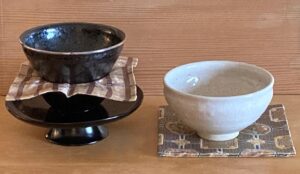
Left: Ten-moku Cha-wan, 天木茶碗, Heaven-eye Tea-bowl, by Oke-tani Tei-ichi, 桶谷定一, on a ko-buku-sa, 古帛紗, old-cloth-gauze, raised on a black-lacquered dai, 台, support.
Right: white ceramic cha-wan, 茶碗, tea-bowl, in the form of Ten-moku, 天目, Heaven-eye, by Kasa-hara-yaki, 笠原焼, Umbrella-field-fired, Shi-no, 志野, Aspire-field. Supported on a ko-buku-sa, 古帛紗, old-cloth-gauze.
In the realm of Chanoyu, tea is prepared as koi-cha, 濃茶, thick-tea, and usu-cha, 薄茶, thin-tea. Koicha is the culmination of a Tea presentation, and is prepared in many different manners called ten-mae, 点前, offer-fore. The differences in the tenmae are because of the nature of the cha-dō-gu, 茶道具, tea-way-tools, and the manner in which they are handled.
Tea-drinking began in India, and later in China, Korea, and Japan. The utensils were made primarily in China, and were imported to Japan by Buddhist monks who studied in China. Tea, together with Zen, was brought to Japan where Zen temples were founded with accompanying Tea preparation practices. Tea was prepared and drunk from bowls that originated in Song China, and were called by the place where the bowls were made; Ten-moku, 天目, Heaven-eye. The Tenmoku chawan is conical in form, which may be modeled on the seed pod of the lotus plant; hasu, 蓮, lotus. The lotus is sacred to Buddhism, and is used as a support for all images of Buddhist deities: ren-dai, 蓮台, lotus-support.
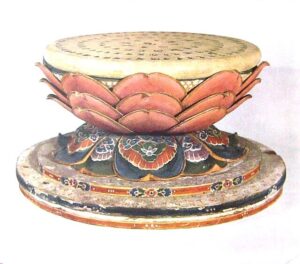
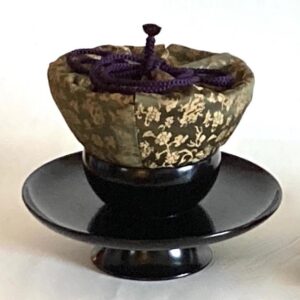
The shifuku of the Tenmoku chawan seems to emulate the petals of the ren-dai, lotus-support. This is more apparent when the kobukusa is placed between the chawan and the dai, pictured above.
Because of the elevated nature of Tea prepared in Buddhist temples, the bowl, like virtually everything offered to deity, is raised in some manner. The Tenmoku tea bowl was offered to the honored spirit raised on lathe-turned wooden dai, 台, support. The Buddhist community of priests, monks, and others drank tea in the same way, with the Tenmoku ja-wan supported on the dai.
Major changes occurred in Japan when the utensil came from China or Korea.
When presented to the guest or guests, a kobukusa may or may not be included. In a simple presentations of koi-cha, 濃茶, thick-tea, in a chawan that is not Raku yaki, 楽焼, Pleasure fired, a folded kobukusa is placed alongside of the chawan when presented to the guest. The shō-kyaku, 正客, main-guest, moves to get the chawan and the kobukusa, and returns to his or her seat. The kobukusa is placed inside the heri, 縁, edge, away from the other guests. The chawan is placed inside the heri toward the ji-kyaku, 次客, next-guest. All of the guests bow in unison in the manner of gyō, 行, transition, which is to signify unity among the guests. The teishu does not bow at this moment. The shōkyaku tells the teishu that the kobukusa will be used: ‘kobukusa hai-shaku itashimasu’, 古帛紗を拝借いたします, old-cloth-gauze revere-borrow.
When the chawan is on the kobukusa, it is passed, hand to hand, between the guests. When the last guest finishes the tea, the kobukusa is separated from the chawan. The guests then look carefully at the chawan and kobukusa called hai-ken, 拝見, revere-see.
In the Tea presentation, Cha-wan Kazari, 茶碗荘, tea-bowl solemn, the revered chawan is offered to the guest, the bowl is placed on a shifuku, 仕覆, serve-invert, including a Raku chawan. This procedure seems to identify the use of the kobukusa with a Raku teabowl that has some other significance. It is thought that a kobukusa is used to protect the hands from the heat of the tea in the chawan, which often occurs with a large amount of tea in a bowl of koicha for a number of persons. The kobukusa is not used when offering tea to a ki-nin, 貴人, noble-person.
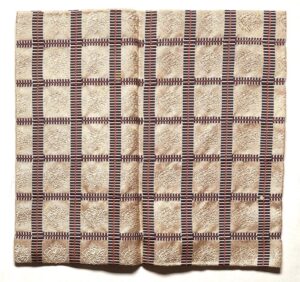
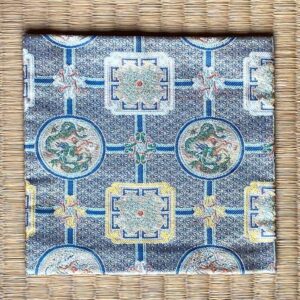
The kobukusa is shown on Kyō tatami, as the size of the kobukusa appears to have some relationship to the weave of the tatami. There are various sizes of tatami weave and grasses. The preferred grass for making tatami is i-gusa, 藺草, rush-grass, Juncus effusus var. decipiens. It should be understood that the fine silk fabric and the somewhat coarse tatami are both created by weavers. The meditating Buddha sat under a pipal tree seated on some grasses called in Sanskrit kuśa. It is curious that the Japanese word for grass is kusa, 草.
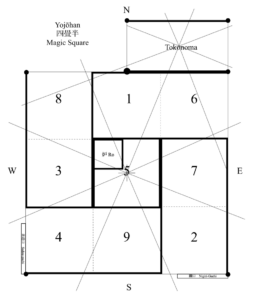
The magic square originated in China as huàn fāng, 幻方, apparition-direction, which in Japanese is ma-hō-jin, 魔方陣, demon-direction-position. The four and a half tatami mats are reckoned as nine half-mats, creating nine squares. These are likened to the magic square and its numbers from 1 to 9. The numbers are arranged with the number 5 in the center, surrounded by the remaining eight numbers. The odd numbers, including 5, 1, 3, 7, 9, which are identified as Yō, 陽, Positive, are in the middle of each side with the number 1 in the north. The even numbers, which are identified as In, 陰, Negative, are at the corners. The numbers 2, 4, 6, 8 are identified as In because they can be divided equally in half. Each row of numbers, including the diagonals, when added together total 15. There are other magic squares with a greater number of double digit or more numerals.
Such magic squares are found in various cultures including Hindu and Buddhist iconography in the form geometric images such as mandala: Jpn. man-da-ra, 曼荼羅, wide-weed-spread. Mandara are stylized depictions of sacred spirit realms, with multiple images of numerous deities. In many of the Japanese Buddhist mandara, the central image is of Dai-nichi Nyo-rai, 大日如来, Great-sun Like-become, the universe made manifest. In Chanoyu, the host, tei-shu, 亭主, host-master, may be identified as an earthly representative of Dainichi. The most prominent mandara in Japanese Buddhism are a pair called the Ryō-kai Man-da-ra, 両界曼荼羅, Both-world Wide-weed-spread; comprised of the Tai-zō-kai Mandara, 胎蔵界曼荼羅, Womb-treasure-world Mandara, and the Kon-gō-kai Mandara, 金剛界曼荼羅, Gold-strength-world Mandara.
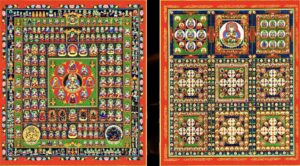
Ryō-kai Man-da-ra, 両界曼荼羅, Both-world Wide-weed-spread. Left: Tai-zō-kai Man-da-ra, 胎蔵界曼荼羅, Womb-treasure-world Mandala. Right: Kon-gō-kai Man-da-ra, 金剛界曼荼羅, Gold-strength-world Mandala. The principle design of the Kongōkai Mandara is like the magic square. The same is true with the pattern of nine squares of the tatami in the yojōhan chashitsu.
For further study, see also: Chakin and Lotus, Kobukusa Origins, Eight-Ten: Fukusa, Kobukusa and Mandala Part 2, Kobukusa Picture Gallery, and Tokonoma and Imae

